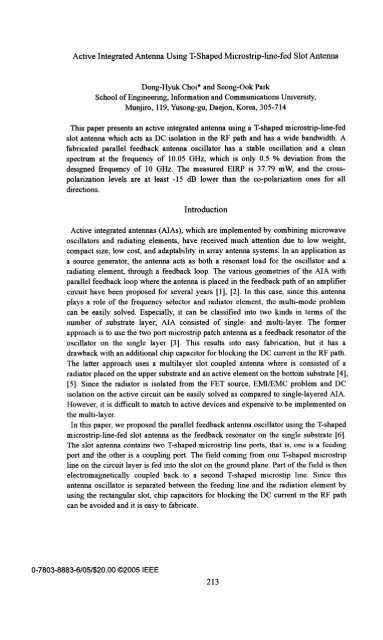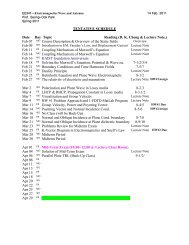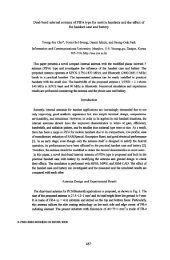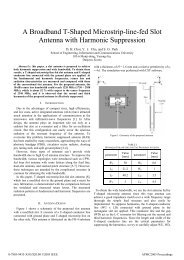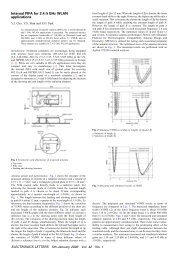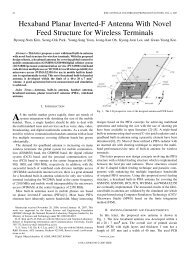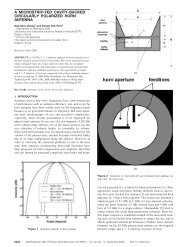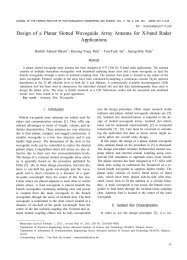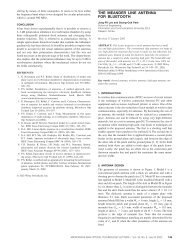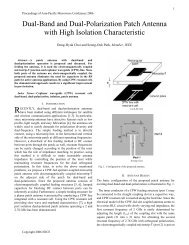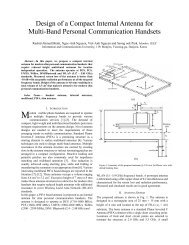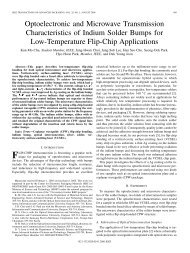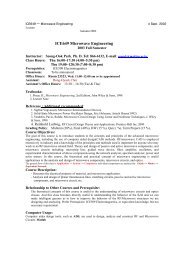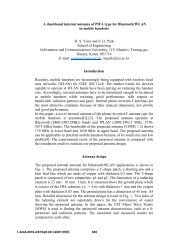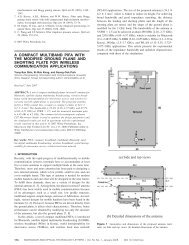Introduction 0-7803-8883-6105/$20.00 ©2005 IEEE
Introduction 0-7803-8883-6105/$20.00 ©2005 IEEE
Introduction 0-7803-8883-6105/$20.00 ©2005 IEEE
Create successful ePaper yourself
Turn your PDF publications into a flip-book with our unique Google optimized e-Paper software.
Active Integrated Antenna Using T-Shaped Microstrip-line-fed Slot Antenna<br />
Dong-Hyuk Choi* and Seong-Ook Park<br />
School of Engineering, Information and Communications University,<br />
Munjiro, 119, Yusong-gu, Daejon, Korea, 305-714<br />
This paper presents an active integrated antenna using a T-shaped microstrip-line-fed<br />
slot antenna which acts as DC isolation in the RF path and has a wide bandwidth. A<br />
fabricated parallel feedback antenna oscillator has a stable oscillation and a clean<br />
spectrum at the frequency of 10.05 GHz, which is only 0.5 % deviation from the<br />
designed frequency of 10 GHz. The measured EIRP is 37.79 mW, and the crosspolarization<br />
levels are at least -15 dB lower than the co-polarization ones for all<br />
directions.<br />
<strong>Introduction</strong><br />
Active integrated antennas (AlAs), which are implemented by combining microwave<br />
oscillators and radiating elements, have received much attention due to low weight,<br />
compact size, low cost, and adaptability in array antenna systems. In an application as<br />
a source generator, the antenna acts as both a resonant load for the oscillator and a<br />
radiating element, through a feedback loop. The various geometries of the AIA with<br />
parallel feedback loop where the antenna is placed in the feedback path of an amplifier<br />
circuit have been proposed for several years [1], [2]. In this case, since this antenna<br />
plays a role of the frequency selector and radiator element, the multi-mode problem<br />
can be easily solved. Especially, it can be classified into two kinds in terms of the<br />
number of substrate layer; AIA consisted of single- and multi-layer. The former<br />
approach is to use the two port microstrip patch antenna as a feedback resonator of the<br />
oscillator on the single layer [3]. This results into easy fabrication, but it has a<br />
drawback with an additional chip capacitor for blocking the DC current in the RF path.<br />
The latter approach uses a multilayer slot coupled antenna where is consisted of a<br />
radiator placed on the upper substrate and an active element on the bottom substrate [4],<br />
[5]. Since the radiator is isolated from the FET source, EMI/EMC problem and DC<br />
isolation on the active circuit can be easily solved as compared to single-layered AIA.<br />
However, it is difficult to match to active devices and expensive to be implemented on<br />
the multi-layer.<br />
In this paper, we proposed the parallel feedback antenna oscillator using the T-shaped<br />
microstrip-line-fed slot antenna as the feedback resonator on the single substrate [6].<br />
The slot antenna contains two T-shaped microstrip line ports, that is, one is a feeding<br />
port and the other is a coupling port. The field coming from one T-shaped microstrip<br />
line on the circuit layer is fed into the slot on the ground plane. Part of the field is then<br />
electromagnetically coupled back to a second T-shaped microstip line. Since this<br />
antenna oscillator is separated between the feeding line and the radiation element by<br />
using the rectangular slot, chip capacitors for blocking the DC current in the RF path<br />
can be avoided and it is easy to fabricate.<br />
0-<strong>7803</strong>-<strong>8883</strong>-<strong>6105</strong>/<strong>$20.00</strong> ©2005 <strong>IEEE</strong><br />
213
Feedback Antenna Oscillator Design<br />
The proposed AIA configuration is shown in Fig. 1. The oscillator contains an<br />
amplifier and an electromagnetically coupling T-shaped microstrip-line-fed slot<br />
antenna. Extra microstrip lines placed both opposite sides of the rectangular slot are<br />
required to adjust the loop phase (multiple of 2x at the operating frequency) for<br />
oscillation. In order to maintain the constant load impedance at each antenna port, the<br />
proper input and output matching circuit was designed. The oscillator was fabricated<br />
on the substrate with thickness of 0.508 mm and relative dielectric constant (&,) of 3.0.<br />
For an operating frequency of 10 GHz, we let the slot has a size L x W of 4.3 x 10.8<br />
mm2 with an optimized T-microstip line length wi = 8.8 mm and the width of 1.56 mm<br />
which is the same as the width of 50 Q2 microstrip line, and then vary the distances li<br />
and l. The results come out to be l = 0.2 mm and lg = 1.04 mm. With these parameters,<br />
a two-port T-shaped microstrip-line-fed slot antenna is fabricated and measured.<br />
Fig. 2 shows the measured and simulated results of the S-parameters for the two-port<br />
slot antenna. At the center frequency of 10 GHz, the measured return loss of the<br />
feeding is approximately -34 dB and the coupling power is -3.6 dB. The impedance<br />
bandwidth (2:1 VSWR) is 27 %, which show a wide bandwidth. It seen that the<br />
measured results agree very well with those of the simulations.<br />
Measurement<br />
A bias condition for the oscillator with an ATF-13786 GaAs MESFET is VDS = 3 V<br />
and VGs = 0.5 V with a drain current (IDS) of 30 mA, and the oscillator is driven by the<br />
self-biasing technique.<br />
Fig. 3 shows the radiated output power from the fabricated feedback antenna<br />
oscillator measured in anechoic chamber. This oscillation frequency is measured at<br />
10.05 GHz, which is 0.5 % close to the frequency of 10 GHz. The output power is<br />
measured about -20.75 dBm using an Agilent E4440A spectrum analyzer and a hom<br />
antenna (Gain = 16.5 dBi) as a reference antenna away from a distance of 1.2 m. An<br />
EIRP (Effective Isotropic Radiated Power) correspond to the above data is 37.79 mW.<br />
The simulated and measured radiation pattems for x-z plane and y-z plane are shown<br />
in Fig. 4. In order to maintain the same measuring environment, the simulated radiation<br />
patterns are calculated by using the gap source technique, in the commercial EM<br />
simulator HFSS, considering the complete feedback active antenna which has same<br />
layout except an active transistor. Both of the radiation patterns are similar to those of<br />
the x-directed dipole antenna. The received cross-polarizations in the x-z plane and y-z<br />
plane of the AIA are approximately -20 dB and -15 dB lower than the maximum copolarized<br />
radiation, respectively. The measured co-polarized radiation patterns in the x-<br />
z and y-z plane have a similar trend with those of the simulated results.<br />
Conclusion<br />
In this paper, the feedback antenna oscillator using the T-shaped microstrip-line-fed<br />
slot antenna is proposed. The fabricated active antenna is investigated with the<br />
comparison of the measured and simulated results. The oscillator antenna achieves an<br />
214
EIRP of 37.79 mW and the cross-polarization level in the x-z and y-z plane are less<br />
than -20 dB and -15 dB, respectively Since the T-shaped microstrip-line-fed slot<br />
antenna utilizes the electromagnetic slot coupling on both layer of the single substrate,<br />
we have some advantages such as no need of the chip capacitor for DC isolation, easy<br />
fabrication, and reduction of EMI/EMC problems between active device and antenna.<br />
This means that a cost and unnecessary effort by attaching the capacitor is able to be<br />
cut down.<br />
References:<br />
[1] R. D. Martinez and R. C. Compton, "High efficiency FET/microstrip-patch<br />
oscillator," <strong>IEEE</strong> Antennas & Propagat. Mag., vol. 36, pp. 16-19, February 2003.<br />
[2] J. A. Hagerty and Z. Popovic, "A 10 GHz integrated Class-E oscillating annular<br />
ring element for high-efficiecy transmitting arrays," <strong>IEEE</strong> MTT-S Digest, vol. 2,<br />
pp. 1317-1320, June 2002.<br />
[3] K. Chang, K. A. Hummer, and G K. Gopalakrishnan, "Active radiating element<br />
using FET source integrated with microstrip patch antenna," Electron. Lett., vol.<br />
24, pp. 1347-1348, October 1988.<br />
[4] W J. Tseng and S. J. Chung, "Analysis and application of a two-port aperturecoupled<br />
microstrip antenna," <strong>IEEE</strong> Trans. Microwave Theory Tech., vol. 46, pp.<br />
530-535, May 1998.<br />
[5] Ying Shen, R. Fralich, Chun Wu, and J. Litva, "Active radiating element using<br />
FET source integrated with a multilayer slot coupled patch antenna," <strong>IEEE</strong><br />
Antenna & propagation society, Int. Symp., vol. 2, pp. 1052-1055, July 1992.<br />
[6] M. K. Kim, Y. H. Suh, and I. M. Park, "A T-shaped microstrip-line-fed wide slot<br />
antenna," <strong>IEEE</strong> Antenna & propagation society, Int. Symp., vol. 3, pp. 1500-1503,<br />
July 2002.<br />
output<br />
IZ<br />
substrate<br />
/ , // ,<br />
ground<br />
slot<br />
ATF-13786<br />
W VW VW<br />
(a)<br />
(b)<br />
Fig. 1. (a) Two-port T-shaped microstrip-line-fed slot antenna. (b) Geometry of<br />
feedback antenna oscillator<br />
215
6<br />
.10<br />
E2<br />
'O<br />
,h<br />
|____ SDh_7 S<br />
Mus eIIDe 1<br />
Freqency [GHz]<br />
Fig. 2. Measured and simulated S-parameters for two-port slot antenna<br />
Mk,l 10.051 4 GHz<br />
R,f e -B Rtt.-ed -e.s dB.-<br />
H0 --- I dB/I<br />
Connon 10.5) 4 6Hz Son 100 OL<br />
S3VS2I<br />
S3CO 1.61 _L~ e(f)RR~~~~.<br />
FT.n<br />
SoO<br />
Sr __ I' ,<br />
C-nte 10.e51 4 GHz S-a l1fl MUz<br />
R.s BW 910 OHs 6B5 910 kHz S...0 I (6et01')<br />
Fig. 3. Measured output power radiated from feedback antenna oscillator<br />
(a)<br />
(b)<br />
Fig. 4. Radiation pattems in (a) x-z plane and (b) y-z plane, at 10.05 GHz<br />
216


